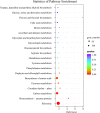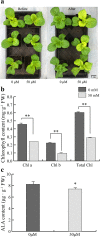Cold acclimation can specifically inhibit chlorophyll biosynthesis in young leaves of Pakchoi
- PMID: 33838654
- PMCID: PMC8035748
- DOI: 10.1186/s12870-021-02954-2
Cold acclimation can specifically inhibit chlorophyll biosynthesis in young leaves of Pakchoi
Abstract
Background: Leaf color is an important trait in breeding of leafy vegetables. Y-05, a pakchoi (Brassica rapa ssp. chinensis) cultivar, displays yellow inner (YIN) and green outer leaves (GOU) after cold acclimation. However, the mechanism of this special phenotype remains elusive.
Results: We assumed that the yellow leaf phenotype of Y-05 maybe caused by low chlorophyll content. Pigments measurements and transmission electron microscopy (TEM) analysis showed that the yellow phenotype is closely related with decreased chlorophyll content and undeveloped thylakoids in chloroplast. Transcriptomes and metabolomes sequencing were next performed on YIN and GOU. The transcriptomes data showed that 4887 differentially expressed genes (DEGs) between the YIN and GOU leaves were mostly enriched in the chloroplast- and chlorophyll-related categories, indicating that the chlorophyll biosynthesis is mainly affected during cold acclimation. Together with metabolomes data, the inhibition of chlorophyll biosynthesis is contributed by blocked 5-aminolevulinic acid (ALA) synthesis in yellow inner leaves, which is further verified by complementary and inhibitory experiments of ALA. Furthermore, we found that the blocked ALA is closely associated with increased BrFLU expression, which is indirectly altered by cold acclimation. In BrFLU-silenced pakchoi Y-05, cold-acclimated leaves still showed green phenotype and higher chlorophyll content compared with control, meaning silencing of BrFLU can rescue the leaf yellowing induced by cold acclimation.
Conclusions: Our findings suggested that cold acclimation can indirectly promote the expression of BrFLU in inner leaves of Y-05 to block ALA synthesis, resulting in decreased chlorophyll content and leaf yellowing. This study revealed the underlying mechanisms of leaves color change in cold-acclimated Y-05.
Keywords: 5-aminolevulinic acid (ALA); BrFLU; Chlorophyll biosynthesis; Cold acclimation; Leaf color conversion; Pakchoi.
Conflict of interest statement
The authors declare that they have no competing interests.
Figures








Similar articles
-
Comparative transcriptome analysis reveals that chlorophyll metabolism contributes to leaf color changes in wucai (Brassica campestris L.) in response to cold.BMC Plant Biol. 2021 Sep 28;21(1):438. doi: 10.1186/s12870-021-03218-9. BMC Plant Biol. 2021. PMID: 34583634 Free PMC article.
-
Comparative Proteomic Analysis Reveals That Chlorophyll Metabolism Contributes to Leaf Color Changes in Wucai ( Brassica campestris L.) Responding to Cold Acclimation.J Proteome Res. 2019 Jun 7;18(6):2478-2492. doi: 10.1021/acs.jproteome.9b00016. Epub 2019 May 8. J Proteome Res. 2019. PMID: 31038978
-
Transcriptome profiling of two contrasting ornamental cabbage (Brassica oleracea var. acephala) lines provides insights into purple and white inner leaf pigmentation.BMC Genomics. 2018 Nov 6;19(1):797. doi: 10.1186/s12864-018-5199-3. BMC Genomics. 2018. PMID: 30400854 Free PMC article.
-
Identification of two recessive etiolation genes (py1, py2) in pakchoi (Brassica rapa L. ssp. chinensis).BMC Plant Biol. 2020 Feb 10;20(1):68. doi: 10.1186/s12870-020-2271-3. BMC Plant Biol. 2020. PMID: 32041529 Free PMC article.
-
Photosynthesis and resource distribution through plant canopies.Plant Cell Environ. 2007 Sep;30(9):1052-71. doi: 10.1111/j.1365-3040.2007.01683.x. Plant Cell Environ. 2007. PMID: 17661747 Review.
Cited by
-
Recent applications of metabolomics in plant breeding.Breed Sci. 2022 Mar;72(1):56-65. doi: 10.1270/jsbbs.21065. Epub 2022 Feb 3. Breed Sci. 2022. PMID: 36045891 Free PMC article.
-
Biosynthesis and Extraction of Chlorophyll, Carotenoids, Anthocyanins, and Betalaine In Vivo and In Vitro.Curr Issues Mol Biol. 2024 Sep 23;46(9):10662-10676. doi: 10.3390/cimb46090633. Curr Issues Mol Biol. 2024. PMID: 39329984 Free PMC article. Review.
-
Understanding and Comprehensive Evaluation of Cold Resistance in the Seedlings of Multiple Maize Genotypes.Plants (Basel). 2022 Jul 20;11(14):1881. doi: 10.3390/plants11141881. Plants (Basel). 2022. PMID: 35890515 Free PMC article.
-
Prolong the postharvest shelf life of spinach through the antioxidative ability of melatonin.Food Chem X. 2023 Jun 25;19:100769. doi: 10.1016/j.fochx.2023.100769. eCollection 2023 Oct 30. Food Chem X. 2023. PMID: 37780277 Free PMC article.
-
Function of ALA Content in Porphyrin Metabolism Regulation of Ananas comosus var. bracteatus.Int J Mol Sci. 2023 Mar 9;24(6):5274. doi: 10.3390/ijms24065274. Int J Mol Sci. 2023. PMID: 36982348 Free PMC article.
References
MeSH terms
Substances
LinkOut - more resources
Full Text Sources
Other Literature Sources

